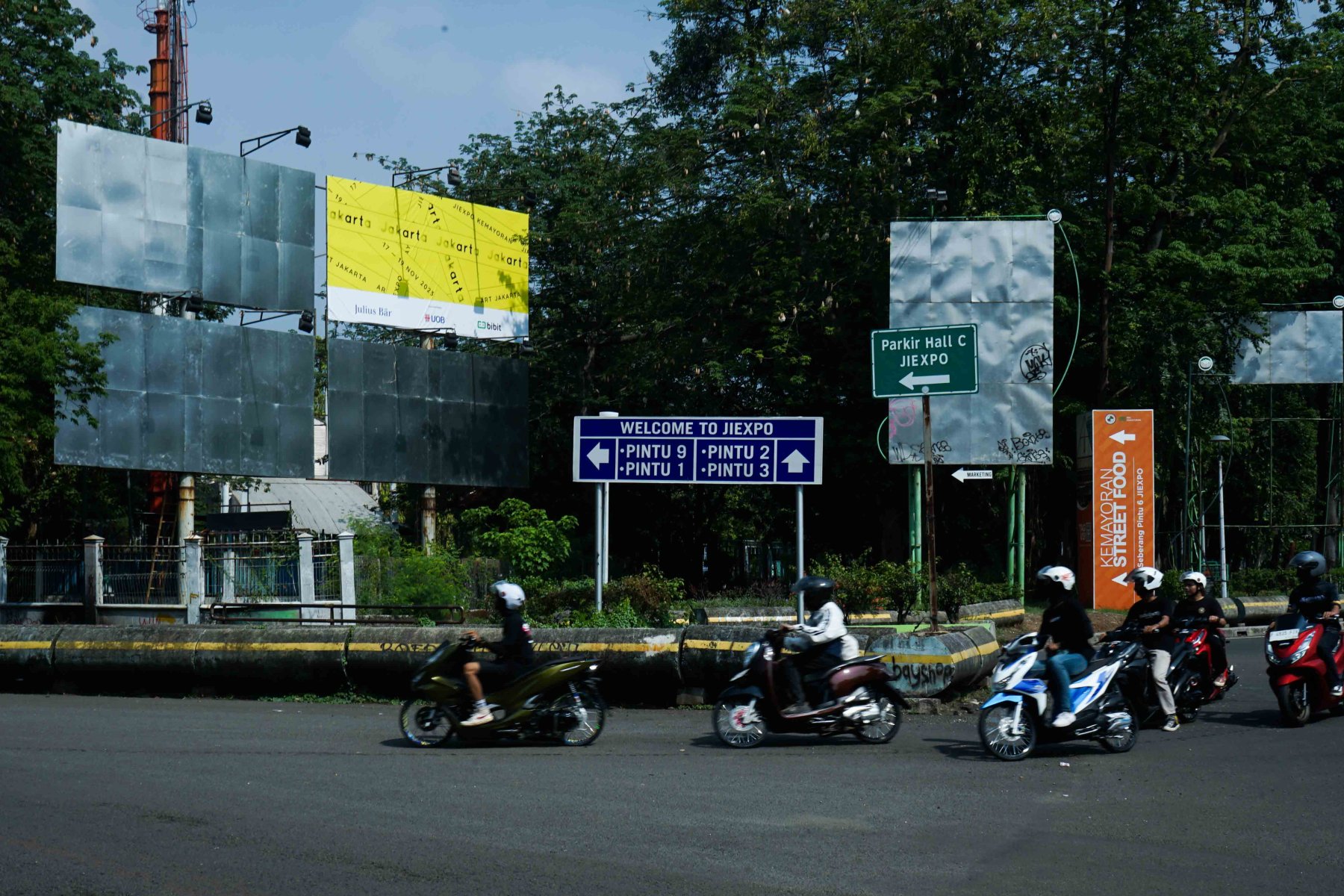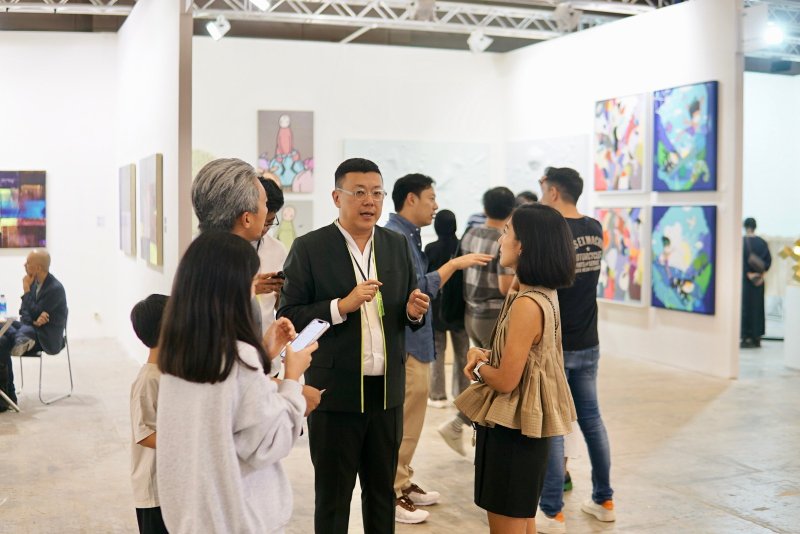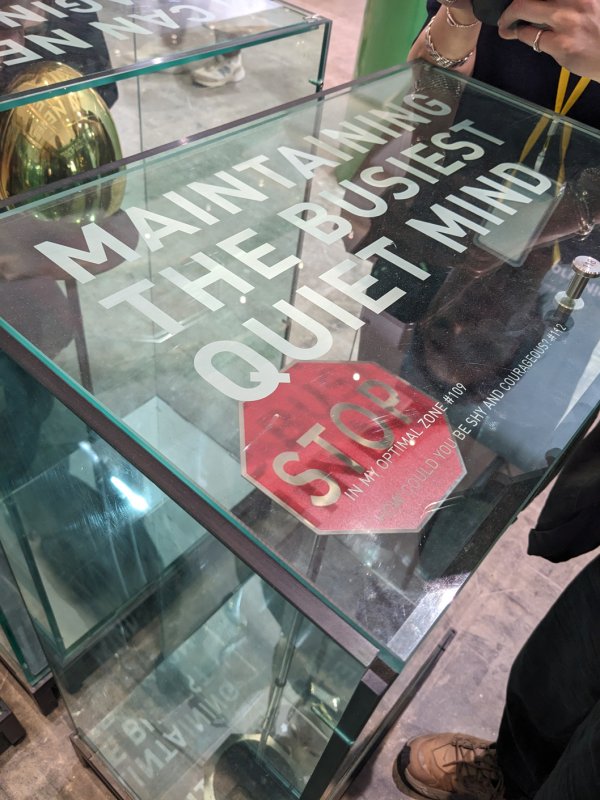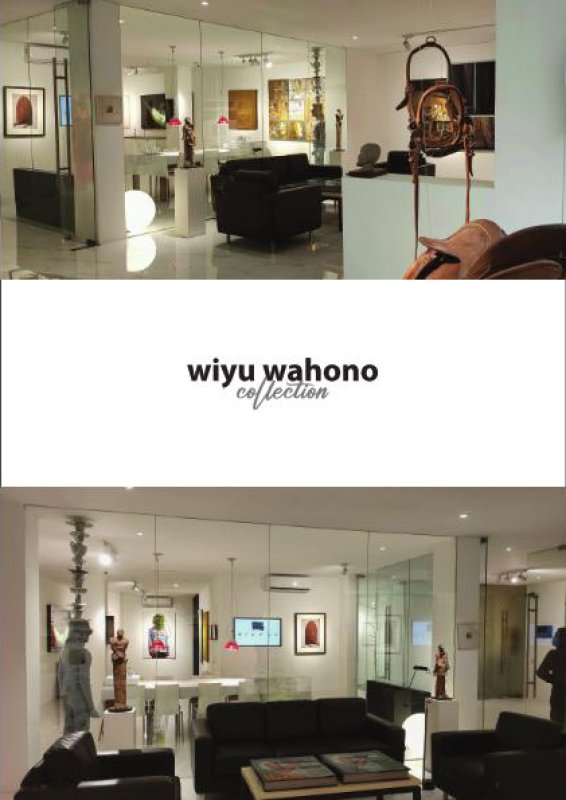The Mirror
EditorialAboutA+a Study CentreA+a ArchiveShopClose Menu

Between 17 to 19 November 2023, seasoned Fair Director and art collector Tom Tandio opened the 13th edition of Art Jakarta at JIEXPO Kemayoran (AJ23), Jakarta, Indonesia. This was the first time the fair was held in large-scale, dedicated, exhibition grounds. As an anchor event for the Indonesian contemporary art market, Art Jakarta attracts seasoned and casual collectors, curators, dealers, and artists. This fair is also one of two fairs in the Southeast Asian region that have consistently offered works by modern masters. In 2023, it further presented the homecoming presentation for Syagini Ratna Wulan’s (b. 1979) Memory Mirror Palace (2023), first presented in the Indonesian Pavilion at the 58th Venice Biennale in 2019. That this major installation was shown at Art Jakarta demonstrates the unique institutional remit of this fair beyond its international peers.
Chloe Ho and Eliza O’Donnell attended Art Jakarta and interviewed ten collectors, dealers, and artists, including Tom Tandio about community, growth, modern art, and authenticity.

Playing Host
‘Welcome to my crib’ – Syagini Ratna Wulan, artist.
At its closing, Art Jakarta 2023 (AJ23) reported 35,578 visitors to JIExpo Kemayoran. This was its 13th edition, and many of the most interesting contemporary artists from Indonesia like Syagini along with fellow artist and life partner Arin Dwihartanto Sunaryo (b. 1978) had joined the international art scene at the same time. ‘We grew up together’, Syagini reflected. Her public work at AJ23, Memory Mirror Palace (2023), consisting of spatialised glass-like acrylic boxes was first presented in Indonesia’s 2019 pavilion at the Venice Biennale. This was Indonesia’s second pavilion in Venice, another indicator of growth for the Indonesian art scene. A homecoming presentation, Syagini’s installation engages its viewer through textual prompts that guide the viewer in a personalised exploration in the maze-palace. AJ23 was Syagini’s art-sibling that, like her, has all grown up.
AJ was born Bazaar Art Jakarta in 2009 with the support of Harper’s Bazaar Indonesia. It was then the first art fair in Indonesia. Since then, boutique art fairs have sprouted in Jakarta, Bali, and Yogyakarta, but AJ remains the largest. The renamed AJ (from 2017) is directed by Tom Tandio, yet another figure who has grown with the fair. Tom had begun his collecting journey in 2007. His debut attendance to Bazaar Art Jakarta in 2009 was as a buyer looking to grow his budding collection. In 2011, he began IndoArtNow, an online archive dedicated to Indonesian contemporary art.1 His foray into the business of art only began in 2014, when then-Fair Director of the Singapore-born Art Stage, Lorenzo Rudolf, invited Tom to join his fair as Regional Director. Tom went on to set up the 2016-17 editions of Art Stage in Jakarta before, amid Lorenzo’s crumbling professional relations in Southeast Asia, returning to Bazaar Art Jakarta as its Fair Director in 2018.2
Attending AJ23 felt like a celebratory landing of Indonesia’s contemporary art scene. In regional terms, Indonesia always had a particularly prominent art market: Affandi, Srihadi Soedarsono, Lee Man Fong, Hendra Gunawan, and many other Indonesian modern masters are household names the way artists are not in other parts of Southeast Asia. This is reflected in the booths found in AJ23: modern dealers (Art Agenda x Art:1 Museum, Moon’s Arts, and Neo Gallery) took up a good amount of space. In fact, Christies used to have a booth when the fair was named Bazaar Art Jakarta, before their Southeast Asian offices were consolidated in Hong Kong. Wang Zineng, founder of Art Agenda, reflected that it was under the auspices of the international auction house that he first attended the fair. Indonesian contemporary art has also been a consistent presence in all major and minor exhibitions and festivals internationally over the past three decades.
There was a different sentiment that accompanied the awakening maturity in the air at AJ23. The combination of a new location, new fair organisation, and new international accolades seemed to vitalise AJ23 with quiet confidence and strength. While there is still space to grow, a sentiment shared by seasoned collectors Konfir Kabo (Founder, Project Eleven & Member of the Board of Young Collectors, Art Jakarta) and Wiyu Wahono (Member of the Board of Young Collectors, Art Jakarta), Tom’s AJ is more than a market: it is a center for the making, presentation, sale, and exchange of Indonesian modern and contemporary art.

One of the first things Tom did was move AJ out of the hotel ballroom of The Ritz Carlton Jakarta, Pacific Place, in South Jakarta. From the Jakarta Convention Center (JCC) in 2019, AJ moved again in 2023 to JIExpo, a 10,000sqm relatively isolated exhibition hall in central Jakarta. Bucking superficial early speculations, this isolation unveiled positively: Syagini and Arin both agreed that art aficionados were staying longer at the fair. Despite higher visitorship numbers, Tom observed that the crowd in JIExpo were ‘more serious, not only taking selfies’. Further, JIExpo cut through the frenetic pace of Jakarta’s city life. Nothing else lay between AJ23 and the visitor when arriving at JIExpo, a seemingly inconsequential improvement that drew surprised murmurs of appreciation among seasoned journalists during our media preview. There were no long elevator rides, no treks across busy and expansive shopping areas, and no busy foot traffic between us and the fair. The moment we got off the bus, we were at AJ23.
When interviewed, Tom described AJ23 as a ‘community-based fair … {reflecting} … not only the passion of individual collectors but also the shared commitment to promoting and celebrating contemporary art on a broader scale.’ As a local artist, Syagini could count on her community to support her every step of the way, from logistics to installation, promotion to on-site support. For Syagini, AJ23 was a place where she could make ‘crazy work’ without having to worry. Zineng agreed. In AJ23, his booth was a collaboration with Martha Gunawan, founder of Art:1 Museum just a stone’s throw away from JIExpo. Their Art Agenda x Art:1 booth was one of the larger booths at the fair, and the largest showing mid-twentieth century Indonesian paintings. As we chatted on the eve of the fair, Zineng received a message from a fellow dealer. They had extra carpet, the message informed Zineng. Would his booth need some? AJ is the shared crib of artists and dealers alike: like Syagini, Zineng played host.
Buyers’ Confidence
In addition to the new fair venue, AJ23 also welcomed the inaugural Art Jakarta Authentication and Verification Committee. Modelled on The European Fine Art Foundation (TEFAF) Maastricht’s vetting process for antiques and works of art, exhibiting dealers were invited to submit images of any artwork dated before 1990 for authentication prior to the opening of the fair. According to Zineng, the Committee’s task was to, ‘give a decisive “Yes” or “No” opinion on the authenticity of the artworks, and thereby their admissibility to the art fair.’ If the work does not receive a majority consensus from the Committee, it is called upon for an in-situ physical assessment. From here, the work must receive a majority tick of approval from the Committee and if not, the fair will request the exhibitor not to show it.
The 2023 Authentication and Verification Committee comprised of five independent local art market experts and scholars, Wang Zineng, Agus Dermawan, Inda Noehardi, Mikke Susanto, and Siont Teja. The collective expertise of the newly formed Committee reflects Art Jakarta’s commitment to upholding the integrity of the fair by ensuring the authenticity of works presented and sold. For dealers and collectors of Indonesia’s modern masters, it is perhaps not surprising that such verification measures are being introduced given the prevalence of counterfeit paintings circulating in the secondary art market. Prominent Indonesian artists including Affandi, Hendra Gunawan, S. Sudjojono, and their contemporaries, Popo Iskandar, Srihadi Soedarsono, Jeihan Sukmantoro and Lee Man Fong among others, have been targets of the fake painting trade since the 1990s, and it is a practice that continues today. For Konfir, ‘the issue with modern art is the lack of provenance and documentation.’ Wiyu agreed, and further proposed that ‘buying from reputable galleries can minimise the risk.’ Exhibiting at Art Jakarta does work to improve modern dealers’ reputations: Zineng meets new potential collectors to educate and convert them to clients every year. The Committee’s oversight, which Tom hopes to manifest as visual markers on the artwork caption tags next year, should further support collector confidence, help develop trustworthy relationships with dealers, and build secure collections.

While Konfir and Wiyu are both collectors of contemporary works, they are also concerned with market authenticity issues. However, their worries are less urgent than the modern art collector. Wiyu believes that his ‘risk of getting a counterfeit is very small {because} most of the artists {he collects} are still alive’, indicating that meeting the makers behind the art was part of his process. Similarly, dealing directly with the artist or developing relationships with trustworthy dealers is essential for Konfir’s collecting practice. ‘High touch’ was a key phrase during our interview with Cohart founders Shyevin Sng and Kendall Warson. A San Francisco-based art and technological startup, Cohart’s web app curates a digital space for the 84% of artists internationally who lack gallery representation and support. Yet despite their emphasis on the digital, they make it a point to visit and support the artists, collectors, curators, and other artistic practitioners who interact on the Cohart platform. In October, Cohart collaborated with PAPER Magazine for a Halloween party in New York. In December, they held a dance party at Art Basel Miami Beach. In Jakarta, where they were managing the VIP collectors’ home tours, they brought artists to collectors, and collectors to collectors, physicalising the connections their app offered for the rest of the year. They further hosted a dinner event that brought artists, collectors, emerging collectors, and art researchers into the same room, tapping into that exact same concern for authenticity in contemporary art.
Art Jakarta as Community Fringe Festival

National pavilions from the Venice Biennale typically precede a similar show of institutional proportions in their home countries. In Australia, we saw this most recently with Angelica Mesiti’s ASSEMBLY, brought ‘home’ to the National Gallery of Australia (PROJECT 3: ANGELICA MESITI, 5 November 2022 – 29 January 2023). Sāmoan artist Yuki Kihara’s Paradise Camp, curated by Australian Natalie King, is ongoing at Powerhouse Museum in Sydney (24 March 2023 – 4 February 2024) and will return ‘home’ next year, to Saletoga Sands Resort & Spa, Upolu Island, Sāmoa (1 June 2024 - 31 January 2025) where many of the works were produced. There was no homecoming show for the first Indonesian Pavilion by Tintin Wulia, 1001 Martian Homes (13 May – 26 November 2017), as it was linked to Senayan City shopping mall, Jakarta, via a video uplink. The exhibition had already been brought 'home' during the 2017 Indonesian Pavilion. In part an acknowledgement of Tintin’s Australian connections, this work is currently showing in Tintin Wulia: Secrets (RMIT Gallery, 5 December 2023 - 27 January 2024), where Tintin received her PhD in Art. 1001 Martian Homes at RMIT is connected to Tintin Wulia: Disclosures (10 January – 24 February 2024), the artist’s parallel solo exhibition in Baik Art Gallery, Jakarta, Indonesia. There was no parallel uplink for the second Indonesian Pavilion and convention suggests such a show is required after Venice, perhaps at some kind of NGA-like institutional space. That this space is at an art fair, and at a moment when Syagini is not represented by any commercial gallery, provoked no comment by the local fairgoers.3 This siting is clearly unusual, as far as national pavilions go, but not wholly unexpected for Indonesians, as the local audience’s ambivalence indicated.
Curated by the experienced Enin Supriyanto and sponsored by digital investment startup Bibit, Memory Mirror Palace (2023) joined a suite of events that accompanied AJ23 that was only indirectly related to the market. Three book launches—Vice Versa by Indra Leonardi, Illuminations: Selected Media Publications (1988-2023) by Carla Bianpoen and Skena 2000> by Farah Wardani—were held at the fair. None of them were about the art market, even if the market was present in the books’ contents. Dinners, tours, and other parties were held by dealers, artists, and collectors across the city celebrating art and the descent of art aficionados from outside of Jakarta. Reflecting on the warmth of Jakarta, Tom stated that ‘many collectors invite overseas guests, host them, open their houses, and organise events themselves’, alongside the main fair. While these parallel and complementary programs are not unique to the Jakartan or Indonesian scene, the decentralised and voluntary nature of what happens, as well as everyone’s strong Indonesian art focus, is. By taking on the coordinating role for these events that bring no direct financial profit to AJ, the fair serves as an institutional focal point. In this context, where the fair has taken on the responsibilities of a fringe festival, it is only reasonable for Indonesians to view AJ23 as an appropriate “crib” platform for the 2019 Indonesian Pavilion.
Returning Home
Under Tom Tandio’s directorship, Art Jakarta has comprehensively landed in Indonesian hands. Everyone interviewed commented positively on Tom’s openness in how the fair is run, and were clearly invested. In 2023, there were so many collectors offering to show their homes and collections in the AJ VIP program that different tour streams were required to manage itineraries. Wiyu, who has welcomed Art Jakarta visitors to his collection every year, was only able to visit the fair for a few hours during the VIP preview. However, he must attend: ‘Art Jakarta has become the most successful art fair in Southeast Asia.’ Konfir, whose schedule was equally packed this year, agreed. For him, the energy of AJ feeds his addiction in contemporary art and collecting: even a short visit is necessary.

From afar, Australia watches: Sydney- and Jakarta-based art advisor Santy Saptari remarked that the increasing number of local galleries was encouraging to her clients. There is always room to grow and new ideas, like the Authentication and Verification Committee, are being worked on every year. This year, between 2-4 October 2024, Art Jakarta will return to JIExpo Kemayoran, presumably with newer, bigger, and more ambitious plans for their fair. Meanwhile, perhaps their April mid-year outdoor fair, Art Jakarta Gardens, would be something to look into.
1. This community-driven archive currently documents 31,562 artworks by 2,895 artists in 1,558 exhibitions across Indonesia and beyond. See https://indoartnow.com/about
2. In 2016 and 2017, Art Stage Jakarta was held at Sheraton Grand Jakarta Gandaria City Hotel. This location is currently used by ArtMoments Jakarta, a new art fair which began in 2018. ArtMoments is currently held in Jakarta and Bali.
3. When interviewed, Syagini and Arin told us they were representing themselves through Selasar Sunaryo Art Space, founded by Arin’s artist father Pak Sunaryo (b. 1943-).
Author/s: Chloe Ho & Eliza ODonnell
Chloe Ho & Eliza ODonnell. 2023. “Growing Up With Art Jakarta.” Art and Australia 58, no.2 https://artandaustralia.com/58_2/p210/growing-up-with-art-jakarta
Art + Australia Editor-in-Chief: Su Baker Contact: info@artandaustralia.com Receive news from Art + Australia Art + Australia was established in 1963 by Sam Ure-Smith and in 2015 was donated to the Victorian College of the Arts at the University of Melbourne by then publisher and editor Eleonora Triguboff as a gift of the ARTAND Foundation. Art + Australia acknowledges the generous support of the Dr Harold Schenberg Bequest and the Centre of Visual Art, University of Melbourne. @Copyright 2022 Victorian College of the Arts The views expressed in Art + Australia are those of the contributing authors and not necessarily those of the editors or publisher. Art + Australia respects your privacy. Read our Privacy Statement. Art + Australia acknowledges that we live and work on the unceded lands of the people of the Kulin nations who have been and remain traditional owners of this land for tens of thousands of years, and acknowledge and pay our respects to their Elders past, present, and emerging. Art + Australia ISSN 1837-2422
Publisher: Victorian College of the Arts
University of Melbourne
Editor at Large: Edward Colless
Managing Editor: Jeremy Eaton
Art + Australia Study Centre Editor: Suzie Fraser
Digital Archive Researcher: Chloe Ho
Business adviser: Debra Allanson
Design Editors: Karen Ann Donnachie and Andy Simionato (Design adviser. John Warwicker)
University of Melbourne ALL RIGHTS RESERVED
